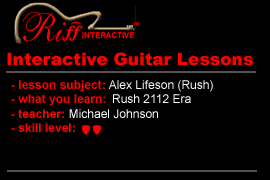Scroll through the lesson and click on notation/video/audio links to load the interactive players.
Please subscribe to get full access to all lessons for only $7.95/month PLUS 1 week free trial.

Riff Interactive lessons are
LESS expensive and
MORE interactive than alternatives!
More Info
|
|

Teacher: Welcome class to the lesson on the
style of Alex Lifeson of Rush. This lesson will cover their 2112 era. This is
when Rush really branched out the create a more progressive sound. This was
unique at the time, because most progressive bands like Yes, Tull, Kansas and
others had 5 or more members in the band. Rush was able to pull it off with 3
musicians. Listen to the lesson sample of the licks and rhythms you will
learn.
Lesson Sample - Lowband - 1.4 Meg
Lesson Sample -
Highband - 3.7 Meg
Teacher: Most of
the guitar parts are easy to play, it's how the arranged all the songs that made
their sound very cool. Let's get started! The opening riff starts with a
staccato rhythmic pattern.
Part 1
Part 1
Teacher:
This section uses all 5 chords (power chords) moving down mostly in 4ths. Make
sure you allow the rest in the phrases to stand out. Here's the jam
track.
Looping Jam
Track 1 - Lowband
Teacher:
You might notice the delay on the jam track. This fills up the space in the
rest. The delay is set at 250 millsecs at 90% effects volume. OK let's jump to
the next section. This rhythm pattern has a triplet groove to it. You use more 5
chords (power chords) in this rhythm
pattern.
Part
2
Part 2
Teacher:
Notice the triplet rhythm has a kind of "gallop" sound typical of sounding like
a horse galloping. This rhythm pattern is used by a lot of heavy metal bands of
the 80s.
ACfixer: Iron Maiden-ish
Teacher: Yes ACfixer, like Iron Maiden, Judas
Priest,... Here's the jam track.
Looping Jam Track 2 - Lowband
Teacher:
Rush helped influence many metal bands, especially Neil Peart with most heavy
metal drummers. Here's the next section, moving in to a dynamic rhythm
part.
Part
3
Part 3
Teacher:
This section starts off with a descending run using the A Mixolydian mood.
Here's the A Mixolydian scale
A Mixolydian
Teacher: The rhythm pattern also uses open
chords, starting from A. You play A, G, D, A using various voicings of A. Here's
the jam track.
Looping Jam Track 3 - Lowband
Jerry: So the
primary key is A.
Teacher: Yes Jerry. Now you will play power
chords that help transition the phrase into the solo. Here's the
chords.
Part 4
Teacher:
These are basic chords except for the D/F#. Next is the rhythm track for the
solo.
Part
5
Teacher:
This rhythm has some cool sounding polytonal chords. Polytonal chords use basic
chord fingerings that utilize open strings. Most of the higher chords use a "C"
chord fingering. Here's the jam track. Here's the jam track, load this file
and you will play the up-coming licks that I will give you next over this
track.
Looping Jam
Track 5 - Lowband
Teacher:
Here's the first part of the solo.
Part 5 - Solo 1
Part 5 - Solo
1
Teacher:
This solo uses the A Minor scale pattern, starting with a bending triple-stop
lick at the beginning. You bend the 3rd string/7th fret with the 3rd finger,
while the 4th finger barres the 1st and 2nd strings on the 8th fret. The lick
moves down to the "B" note on the 4th fret/3rd string.
donnell:
That's hard to do.
Teacher: Donnell, make sure you grab the top of
the neck with your thumb, this way you have a better grip. Notice in bar 3
you ascend the A Minor scale, until in the later part of bar 4 where you shift
into the 2nd box pattern of the A Minor Pentatonic.
A
Minor - A Min Pentatonic - 2nd Box Pattern
Teacher:
Let's move to the second part of the
solo.
Part 5 -
Solo 2
Part 5 - Solo
2
Teacher:
This section continues in the 2nd box pattern of the A Minor Pentatonic and then
shifts back to box 1 of the A Minor Pentatonic on the 5th fret. Next you will
change the rhythm pattern after the
solo.
Part
6
Part 6
Teacher:
Rush/Alex Lifeson will also shift keys to make a composition sound more
interesting. In the example you modulate to the key of E. Notice you use the
open E (6th string) as a pedal tone. A pedal tone is a note that is repeated
throughout a riff. Here's the jam track for this
section.
Looping
Jam Track 6 - Lowband
Teacher:
The composition in the lesson sample ends with a mellow phrase using polytonal
chords. These chords are often used by Alex and the mellow sections add more
dynamics to their songs. Here's the section.
Part 7
Teacher:
These are basically barre chords, only without the 1st and 2nd strings played
open instead of barred. Well I hope this lesson gives you a better idea how Alex
Lifeson and Rush developed the compositions on 2112. Time for me to go, see you
next lesson
irene: thanks
Jerry: good lesson thanx
cm: Thank
you
|
<< load notation from left
|
|
<< load audio from left
|
<< load audio from left
|